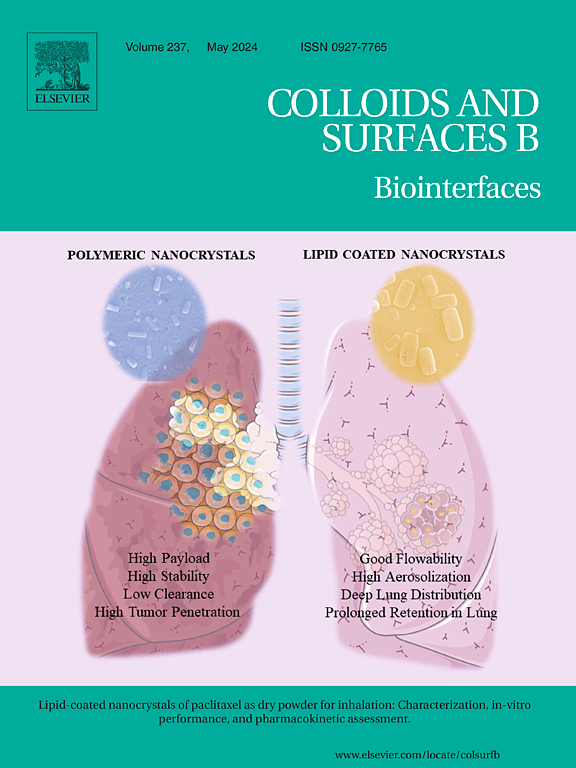通过生物制造在硅藻荧光传感器基底表面富集 CdSe/ZnS 量子点的复合材料
IF 5.4
2区 医学
Q1 BIOPHYSICS
引用次数: 0
摘要
硅藻在数十亿年的生命进化过程中形成了独特的微纳米结构和光子晶体特性。本研究通过生物制造技术制备了一种荧光传感器基底(QD-Diatom),并将 CdSe/ZnS 量子点(QDs)固定在硅藻生物二氧化硅表面。CdSe/ZnS QDs 的浓度为 7.5×10-3 nmol/mL,对硅藻的生长无明显毒性,适合生物制造。QD-Diatom 保留了硅藻的多孔结构,提高了量子点的荧光稳定性。与 DBs 结合后,QDs 的荧光强度增强,波长发生红移。研究了化学试剂和物理煅烧对 QD-Diatom 的纯化。结果表明,通过在 2% 的十二烷基硫酸钠(SDS)或 NaOH 中浸泡并在 180 °C 煅烧 1 小时,可以保持 QDs 的荧光活性并去除有机色素的干扰。QDs 的荧光活性得以保持,有机颜料的干扰也得以消除。这些结果表明,通过简单的生物制造,QD-Diatom 可用作一种新型的荧光生物传感器。本文章由计算机程序翻译,如有差异,请以英文原文为准。
Composite diatom fluorescent sensor substrate enriched with CdSe/ZnS quantum dots on the surface by biofabrication
Diatoms have developed unique micro- and nanostructures and photonic crystal properties during billions of years of life evolution. In this study, a fluorescence sensor substrate (QD-Diatom) was prepared by biofabrication, and CdSe/ZnS quantum dots (QDs) were immobilized on the surface of diatom biosilica. The concentration of CdSe/ZnS QDs of 7.5×10−3 nmol/mL showed no significant toxicity to the growth of the diatom, which is considered suitable for biofabrication. QD-Diatom preserves the porous structure of diatoms and improves the fluorescence stability of quantum dots. Upon binding to DBs, the fluorescence intensity of QDs was enhanced and the wavelength was red-shifted. The purification of QD-Diatom by chemical reagents and physical calcination was investigated. The results showed that the fluorescence activity of QDs could be maintained and the interference of organic pigments could be removed by soaking in 2 % Sodium Dodecyl Sulfate (SDS) or NaOH and calcining at 180 °C for 1 h. The fluorescence activity of QDs could be maintained and the interference of organic pigments could be eliminated. These results indicate that QD-Diatom can be used as a new type of fluorescent biosensor by simple biofabrication.
求助全文
通过发布文献求助,成功后即可免费获取论文全文。
去求助
来源期刊

Colloids and Surfaces B: Biointerfaces
生物-材料科学:生物材料
CiteScore
11.10
自引率
3.40%
发文量
730
审稿时长
42 days
期刊介绍:
Colloids and Surfaces B: Biointerfaces is an international journal devoted to fundamental and applied research on colloid and interfacial phenomena in relation to systems of biological origin, having particular relevance to the medical, pharmaceutical, biotechnological, food and cosmetic fields.
Submissions that: (1) deal solely with biological phenomena and do not describe the physico-chemical or colloid-chemical background and/or mechanism of the phenomena, and (2) deal solely with colloid/interfacial phenomena and do not have appropriate biological content or relevance, are outside the scope of the journal and will not be considered for publication.
The journal publishes regular research papers, reviews, short communications and invited perspective articles, called BioInterface Perspectives. The BioInterface Perspective provide researchers the opportunity to review their own work, as well as provide insight into the work of others that inspired and influenced the author. Regular articles should have a maximum total length of 6,000 words. In addition, a (combined) maximum of 8 normal-sized figures and/or tables is allowed (so for instance 3 tables and 5 figures). For multiple-panel figures each set of two panels equates to one figure. Short communications should not exceed half of the above. It is required to give on the article cover page a short statistical summary of the article listing the total number of words and tables/figures.
 求助内容:
求助内容: 应助结果提醒方式:
应助结果提醒方式:


